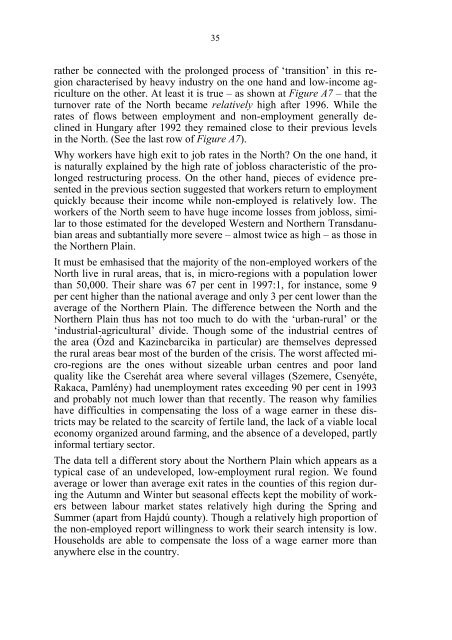BUDAPEST WORKING PAPERS ON THE LABOUR MARKET - MEK
BUDAPEST WORKING PAPERS ON THE LABOUR MARKET - MEK
BUDAPEST WORKING PAPERS ON THE LABOUR MARKET - MEK
- No tags were found...
Create successful ePaper yourself
Turn your PDF publications into a flip-book with our unique Google optimized e-Paper software.
35rather be connected with the prolonged process of ‘transition’ in this regioncharacterised by heavy industry on the one hand and low-income agricultureon the other. At least it is true – as shown at Figure A7 – that theturnover rate of the North became relatively high after 1996. While therates of flows between employment and non-employment generally declinedin Hungary after 1992 they remained close to their previous levelsin the North. (See the last row of Figure A7).Why workers have high exit to job rates in the North? On the one hand, itis naturally explained by the high rate of jobloss characteristic of the prolongedrestructuring process. On the other hand, pieces of evidence presentedin the previous section suggested that workers return to employmentquickly because their income while non-employed is relatively low. Theworkers of the North seem to have huge income losses from jobloss, similarto those estimated for the developed Western and Northern Transdanubianareas and subtantially more severe – almost twice as high – as those inthe Northern Plain.It must be emhasised that the majority of the non-employed workers of theNorth live in rural areas, that is, in micro-regions with a population lowerthan 50,000. Their share was 67 per cent in 1997:1, for instance, some 9per cent higher than the national average and only 3 per cent lower than theaverage of the Northern Plain. The difference between the North and theNorthern Plain thus has not too much to do with the ‘urban-rural’ or the‘industrial-agricultural’ divide. Though some of the industrial centres ofthe area (Ózd and Kazincbarcika in particular) are themselves depressedthe rural areas bear most of the burden of the crisis. The worst affected micro-regionsare the ones without sizeable urban centres and poor landquality like the Cserehát area where several villages (Szemere, Csenyéte,Rakaca, Pamlény) had unemployment rates exceeding 90 per cent in 1993and probably not much lower than that recently. The reason why familieshave difficulties in compensating the loss of a wage earner in these districtsmay be related to the scarcity of fertile land, the lack of a viable localeconomy organized around farming, and the absence of a developed, partlyinformal tertiary sector.The data tell a different story about the Northern Plain which appears as atypical case of an undeveloped, low-employment rural region. We foundaverage or lower than average exit rates in the counties of this region duringthe Autumn and Winter but seasonal effects kept the mobility of workersbetween labour market states relatively high during the Spring andSummer (apart from Hajdú county). Though a relatively high proportion ofthe non-employed report willingness to work their search intensity is low.Households are able to compensate the loss of a wage earner more thananywhere else in the country.







![Letöltés egy fájlban [4.3 MB - PDF]](https://img.yumpu.com/50159926/1/180x260/letaltacs-egy-fajlban-43-mb-pdf.jpg?quality=85)








